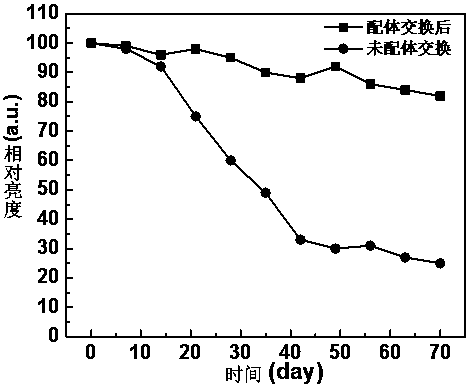Quantum dot surface ligand exchange method
A surface ligand and ligand exchange technology, applied in the field of quantum dots, can solve the problems of weak binding between the surface of quantum dots and ligands, poor stability and dispersion of quantum dot colloidal solutions, etc., and achieve fast reaction rate and strong stability , combined with a firm effect
- Summary
- Abstract
- Description
- Claims
- Application Information
AI Technical Summary
Problems solved by technology
Method used
Image
Examples
Embodiment 1
[0061] 1. Preparation of quantum dots whose surface ligand is octadecenoic acid:
[0062] 1) Preparation of cadmium-zinc oleate precursor solution: Take 0.8mmol CdO, 8mmol zinc acetate, 15 ml oleic acid and 20 ml 1-octadecene in a 100mL three-necked flask, heat to 150°C under Ar atmosphere and exhaust for 1h. Form a transparent cadmium-zinc oleate precursor solution;
[0063] 2) Preparation of Se-S-ODE precursor solution: 0.8 mmol Se and 8 mmol S were dissolved in 6 mL 1-octadecene solution at 140°C to form Se-S-ODE precursor solution;
[0064] 3) Slowly heat the cadmium-zinc oleate precursor solution to 300°C, quickly inject the Se-S-ODE precursor solution once, and keep the reaction for 8 minutes. Then lower the temperature to 100°C, add ethyl acetate to wash, and centrifuge to obtain a precipitate; then add chloroform and acetone and repeat centrifugation twice to obtain a quantum dot precipitate whose surface ligand is octadecenoic acid.
[0065] 2. Deprotonation of prot...
Embodiment 2
[0072] 1. Preparation of ZnO quantum dots whose surface ligand is stearic acid:
[0073] 1) Preparation of zinc stearate precursor solution: Take 2 mmol of zinc stearate and add 30 ml ODE to exhaust with Ar at 130°C for 30 minutes, the solution becomes colorless and transparent, and the zinc stearate precursor solution is obtained;
[0074] 2) Preparation of long-chain alcohol precursor solution: Dissolve 10 mmol ODA in 12.6 ml ODE, degas at 130°C for 30 min, the solution is colorless and transparent, then heat up the solution to 200°C to obtain long-chain alcohol Precursor;
[0075]3) Preparation of ZnO quantum dots: The temperature of the zinc stearate solution was raised to 270 °C, and then the long-chain alcohol solution was quickly injected into the zinc stearate solution once, and the reaction was maintained at 250 °C for 4 min. Then the solution was cooled to room temperature, washed twice to obtain a precipitate, and dried in vacuum at room temperature for 24 h to obt...
Embodiment 3
[0081] 1. Preparation of quantum dots whose ligand is octadecenoic acid:
[0082] 1) Preparation of cadmium-zinc oleate precursor solution: Take 0.8mmol CdO, 8mmol zinc acetate, 15 ml oleic acid and 20 ml 1-octadecene in a 100mL three-necked flask, heat to 150°C under Ar atmosphere and exhaust for 1h. Form a transparent cadmium-zinc oleate precursor solution;
[0083] 2) Preparation of Se-S-ODE precursor solution: 0.8 mmol Se and 8 mmol S were dissolved in 6 mL 1-octadecene solution at 140°C to form Se-S-ODE precursor solution;
[0084] 3) Slowly heat the cadmium-zinc oleate precursor solution to 300°C, quickly inject the Se-S-ODE precursor solution once, and keep the reaction for 8 minutes. Then lower the temperature to 100°C, add ethyl acetate to wash, and centrifuge to obtain a precipitate; then add chloroform and acetone and repeat centrifugation twice to obtain a quantum dot precipitate whose surface ligand is octadecenoic acid.
[0085] 2. Deprotonation of proton-conta...
PUM
 Login to View More
Login to View More Abstract
Description
Claims
Application Information
 Login to View More
Login to View More - R&D
- Intellectual Property
- Life Sciences
- Materials
- Tech Scout
- Unparalleled Data Quality
- Higher Quality Content
- 60% Fewer Hallucinations
Browse by: Latest US Patents, China's latest patents, Technical Efficacy Thesaurus, Application Domain, Technology Topic, Popular Technical Reports.
© 2025 PatSnap. All rights reserved.Legal|Privacy policy|Modern Slavery Act Transparency Statement|Sitemap|About US| Contact US: help@patsnap.com



